Arthrosis is a pathology in which there is a gradual deformation of the joints. In the initial stages, cartilage and ligaments are destroyed. The process proceeds slowly, so the disease is detected already at a late stage of development. In the future, this can lead to loss of mobility and disability.
The risk of developing osteoarthritis increases with age. The disease affects both men and women equally.
Symptoms
Joint pain during movement is the main symptom of the disease, due to which many seek medical help in time. Discomfort manifests itself during long walks or vigorous physical exercises.
What is arthrosis, the doctor will tell during the diagnosis of the disease. Pathology can be suspected when the following symptoms appear:
- night pains resulting from venous blood stagnation and increased pressure within the joint;
- the appearance of a crackle due to the friction of the collapsing cartilage;
- increased pain during heavy loads, this is especially expressed in knee arthrosis during squats, sports (running, jumping, weight lifting), weight bearing;
- meteorological dependence, when the affected joints begin to hurt when the weather changes, especially before heavy, cold rain or snow;
- morning stiffness.
The difference between arthrosis and osteoarthritis, the doctor's answer
A doctor and well-known health TV presenter says that the terms "arthrosis" and "osteoarthritis" mean a disease in which cartilage is damaged and bone tissue grows.
With arthrosis, the cartilaginous tissue of the surface of the joints is destroyed, the mobility of the limbs is limited, severe pain occurs. The pathology is diagnosed in men and women over 40 years old (the main reason in women is the onset of menopause, when hormonal changes occur in the body).
Osteoarthritis is manifested as a result of the deformation of the articular cartilage and affects the bone tissue, affecting the entire joint, leading to disability.
Other diseases with similar symptoms
There are a number of diseases that have signs similar to those of arthrosis:
- Humeroscapular periarthritis, cervical osteochondrosis, osteoporosis and arthritis of the shoulder joint.
- Elbow epicondylitis, deforming osteoarthritis, rheumatoid arthritis of the hand.
- Coxarthrosis.
- Rheumatoid and infectious arthritis in children.
Types of arthrosis according to location
Varieties of the disease vary depending on where the diseased joint is located. The easiest type of pathology is the shoulder. Osteoarthritis can be diagnosed:
- cervical region;
- knee joint (affects both legs, but develops in different degrees);
- ankle;
- hip joint (a characteristic pathology for the elderly).
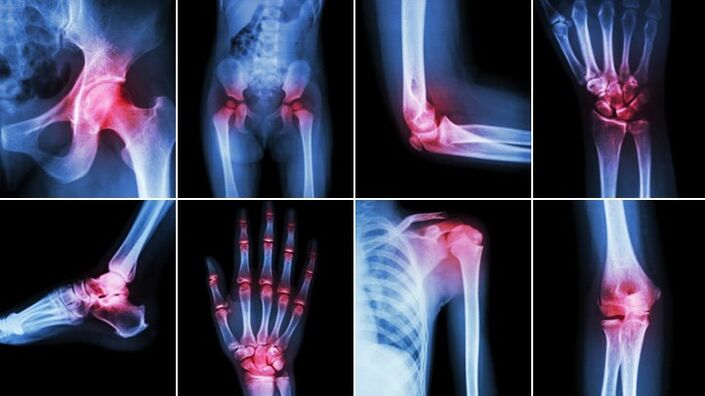
Causes of the disease
The disease can develop without any cause (idiopathic or primary). Pathological processes in the body often provoke a secondary form of pathology. Causes of the development of arthrosis:
- injuries (dislocations, bruises, fractures, ligament tears, meniscus damage);
- congenital abnormalities in joint development (dysplasia);
- metabolic disease;
- autoimmune diseases (rheumatoid arthritis, systemic lupus erythematosus);
- inflammatory processes (acute purulent arthritis);
- infectious diseases (tuberculosis, encephalitis, gonorrhea, syphilis);
- pathology of the endocrine system (thyroid disease);
- hemophilia;
- age-related changes in the body;
- frequent hypothermia.
Diagnosing
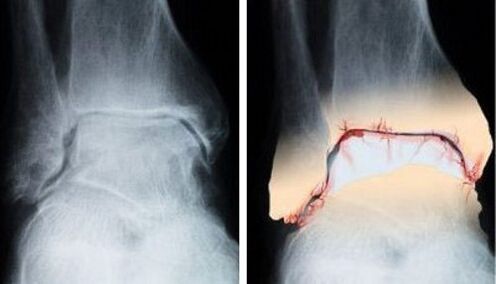
There are several diagnostic methods:
- x-ray examination;
- arthroscopy (examination with a video camera inserted into the joint through a 4-5 mm incision);
- blood analysis;
- histological examination of the synovium (with arthrosis, integrative cells do not regenerate, atrophic villi appear, the number of vessels decreases).

The degree of joint damage
A classification is used, including 4 degrees of disease development.
First stage (the disease does not affect the ability to work):
- slight limitation of joint movement in only one direction;
- no bone growth on x-ray;
- cartilage surfaces are uneven;
- joint space narrowing begins.
The second stage (affects the ability to work):
- moderate limitation of movement;
- strong crackling when changing the position of the limbs;
- partial atrophy of nearby muscles;
- bone growth, osteophytes;
- the lumen of the gap is smaller than the norm by 2-3 times.
Third stage (disability):
- joint deformity;
- movement is limited;
- pain during movement and at rest (relieved by sedatives);
- there is no shared space;
- muscles are atrophied;
- ossification of the articular surface.
The fourth stage:
- severe pain that does not go away after taking painkillers.
- complete destruction of the joint.
Basic Treatments
Arthrosis therapy includes several methods. To achieve a positive result, it is necessary to take medication, monitor weight. Physiotherapy, kinesiotherapy are prescribed. In severe cases, surgical treatment is performed.
mEDICAL
The main task in the treatment of arthrosis is the removal of pain. For this, drugs of different groups are prescribed:
- Non-steroidal drugs in the form of tablets, suppositories, ointments, gels, injections. Long-term use of these drugs negatively affects cartilage tissue.
- Corticosteroids. They are used in severe cases for pain relief, they do not slow down the development of the disease. With uncontrolled use, the cartilage thins.
- Analgesic, antispasmodic. Weakly relieves inflammation, but effective for pain relief.
- Chondroprotectors. These are the main drugs for the treatment of arthrosis, they provide cartilage tissue with nutrients, stimulate cell regeneration. They do not have a quick effect, the condition of the joints improves gradually. Effective even in stage 3 of the disease.
- Vasodilator drugs. It is needed to improve blood circulation, to eliminate spasms of small vessels. Improving the action of chondroprotectors.
Physiotherapy
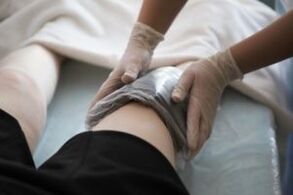
With arthrosis, physiotherapy is used effectively. Procedures include heating the joints. Dry heat slows the destruction of bone and cartilage tissue, reduces pain and improves the general condition of the patient.
The following methods are used to treat the disease:
- ultrasonic impact. High-frequency sound acts on the body's tissues, causing a number of beneficial effects. With micromassage, muscles warm up, blood circulation in the capillaries improves and metabolic processes are accelerated.
- Electrophoresis. Under the influence of a low voltage current, drugs are injected into the problem area without touching other parts of the body.
- magnetic therapy. Application of the method helps reduce inflammatory reactions, strengthens blood vessels, improves blood circulation and accelerates cell regeneration in the problem area.
- Exposure to radiation (use of infrared, ultraviolet or laser radiation). It is used as an addition to other physiotherapy methods or when there are contraindications for their use.
surgery
In the absence of positive dynamics in the treatment of arthrosis, surgical methods are used:
- Operative interventions. There are 4 types: joint-preserving, joint-replacement, joint-resection, joint-strengthening. The choice depends on the degree of development of the disease, on the intensity of the pain, on the individual characteristics of the patient.
- Daughter. It is performed with progressive arthrosis. Performs 2 functions: relieves pain in the damaged joint and relieves tension inside the capsule, removing from it substances that destroy cartilage tissue. It is an informative diagnostic method. During this procedure, after local anesthesia, drugs are injected into the joint.
- Arthroscopy. It is often performed on an outpatient basis. During the procedure, pieces of cartilage or bone can be removed from the joint, the meniscus can be treated, the ligamentous apparatus can be reconstructed, and joint surfaces deformed during arthrosis can be cleaned. It is performed under general or local anesthesia.
- Arthrotomy. Joint opening is performed if arthroscopy has not given a positive result. It is indicated for prolonged joint swelling and persistent severe pain that does not stop with medication. It is advisable if you want to remove large fragments of cartilage or bone tissue.
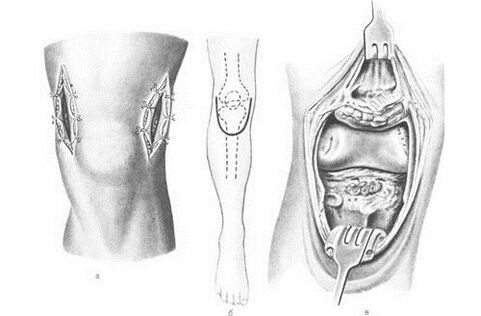
Operations to change the position of the joint are performed in cases where it is necessary to correct the position of the bones, with defects in the structure of the joints, as prevention of arthrosis.
exercise therapy
Physiotherapy exercises can help in the initial stages of the disease, when the joint is not yet deformed. Active movements slow down the course of the disease, but with joint damage, when the disease has passed to the later stages, physical exercises can contribute to the development of deterioration and tissue destruction in the problem area.
You should do it only after consulting a specialist who will help you choose a set of exercises and master the implementation methodology. The first training should be done under the supervision of an instructor.
When performing exercises, you must follow the rules:
- Avoid stress on the injured joint.
- A moderate pace of exercise does not cause joint destruction.
- Rest and exercise should be balanced.
- Heavy loads and high movement intensity cause increased pain and provoke swelling of the joint.
- In any position of the body, it is necessary to remember the correct posture.
Regular exercise therapy exercises help to increase the range of motion, relax the muscles and improve the general condition of the patient.
Manual therapy
In combination with medications in the treatment of arthrosis, manual therapy methods are used that increase the mobility of damaged joints, prevent muscle atrophy and positively affect the patient's entire body.
During the session, the following manipulations are performed:
- Relaxation (complete relaxation) of the muscles that are involved in the work of the diseased joint.
- Performing low-frequency mobilization of the articular surface to expand the range of motion of the joint to the limit of its mobility.
- Acupressure according to the Schwartz method to bring the muscles to a state of rest.
- Use of laser therapy and devices.
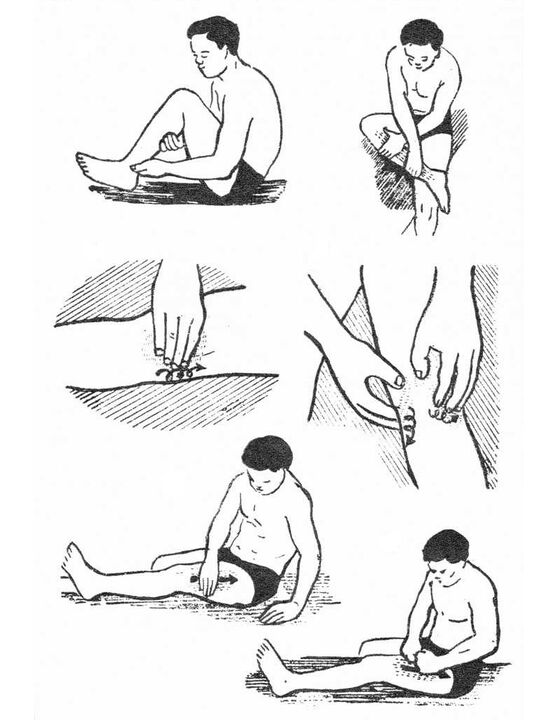
ethnoscience
Folk remedies are actively used in the treatment of arthrosis to activate the production of collagen - the basis of tendons and cartilage. They also relieve joint swelling and reduce pain. Recipes include herbs such as thyme, lentil, dandelion (root), strawberry and birch leaves and willow bark.
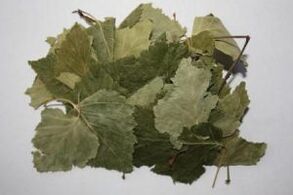
There is a simple but effective way to use birch leaves. To do this, you need to choose comfortable clothes that will fit tightly in the area affected by arthrosis (socks or high socks are suitable for the ankle, tight socks for knee treatment and closed leggings for the jointof the hips). At night, you should cover the diseased joint with leaves and wear suitable clothes. You cannot wrap the fabric with polyethylene.
The leaves remove salts, toxins and cholesterol deposits from the diseased joint, the skin after the procedure becomes smooth and soft. The course of treatment is 6-7 procedures, before use it is necessary to consult a doctor, because. may have contraindications for use.
In folk medicine, ointments, infusions, freshly squeezed juices, compresses are used to fight arthrosis, which are often recommended by doctors in combination with medications. The action of all non-traditional remedies is aimed at reducing pain and swelling of damaged joints, repairing tissues and improving the general condition of the patient.
But you can not engage in self-medication, otherwise complications may appear.
Is it necessary to review the diet?
With arthrosis, it is necessary to adjust the diet, which should be aimed at improving metabolic processes, reducing body weight if necessary, strengthening connective tissues and ligaments and cartilage. There is no special diet. To achieve good results in treatment, the following rules must be observed:
- Consider the caloric content of meals so that in normal weight patients it remains stable and in overweight patients it returns to normal.
- Fatty, smoked dishes, semi-finished products containing flavor enhancers, colors and preservatives are prohibited.
- Products should be natural: low-fat varieties of fish and meat, seafood rich in minerals and vitamins, fresh fruits and vegetables, hard cheese, butter, low-fat cottage cheese, nuts, chicken eggs, rye and bran bread, high quality vegetable oil rich in unsaturated fatty acids.
- It is necessary to limit the daily intake of salt to 8 g.
- Drink at least 2-2. 5 liters of water a day.
- Include in the diet foods that include natural chondroprotectors: lean chicken, cartilage, red fish, hard cheese. Increase the use of gelatin, which normalizes the structure of cartilage tissue, strengthening it. To do this, you need to include in the menu various jellies, jellies, aspic fish, kisses.
- It is necessary to spend 2-3 unloading days per week (curd, kefir, fruit and vegetable days).
What are the risks of different stages of the disease?
In the initial stage of the disease, arthrosis is manifested by periodic pain in the joints and partial limitation of mobility. The danger of the disease is that if you ignore its first symptoms, then in the subsequent stages of development, the pathology will lead to the destruction of joint tissues. Consequences - complete loss of mobility. The patient is assigned a disability group depending on the degree of development of the disease and the condition of the joints.
prevention
Prevention of arthrosis is as follows:
- Body weight control.
- Proper balanced diet.
- Moderate physical activity.
- Avoid joint hypothermia.
- Wearing comfortable shoes.
- Healthy lifestyle.
Conclusion
The risk of the disease is that a person can completely lose mobility. Knowing the symptoms of the disease, the causes of its development and the methods of struggle, you can get rid of the pathology in the early stages.

























